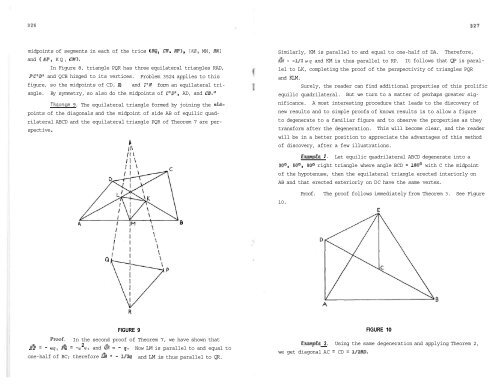Vol. 7 No 5 - Pi Mu Epsilon
Vol. 7 No 5 - Pi Mu Epsilon
Vol. 7 No 5 - Pi Mu Epsilon
You also want an ePaper? Increase the reach of your titles
YUMPU automatically turns print PDFs into web optimized ePapers that Google loves.
midpoints of segments in each of the trios (BQ, CN, RP), (KB, MN, RA)<br />
and (AP, KQ, CM).<br />
In Figure 8, triangle PQR has three equilateral triangles RAD,<br />
PCID' and QCB hinged to its vertices. Problem 3524 applies to this<br />
figure, so the midpoints of CD, AD',<br />
angle. By symmetry, so also do the midpoints of C'D',<br />
and CIB form an equilateral tri-<br />
AD, and CB.I1<br />
The-otem 9. The equilateral triangle formed by joining the rnid-<br />
points of the diagonals and the midpoint of side AB of equilic quad-<br />
rilateral ABCD and the equilateral triangle PQR of Theorem 7 are perspect<br />
ive .<br />
Similarly, KM is parallel to and equal to one-half of DA. Therefore,<br />
iSf = -1/2 n>q and KM is thus parallel to RP. It follows that QP is parallel<br />
to LK, completing the proof of the perspectivity of triangles PQR<br />
and KLM.<br />
Surely, the reader can find additional properties of this prolific<br />
equilic quadrilateral. But we turn to a matter of perhaps greater sig-<br />
nificance. A most interesting procedure that leads to the discovery of<br />
new results and to simple proofs of known results is to allow a figure<br />
to degenerate to a familiar figure and to observe the properties as they<br />
transform after the degeneration. This will become clear, and the reader<br />
will be in a better position to appreciate the advantages of this method<br />
of discovery, after a few illustrations.<br />
EXamph 1. Let equilic quadrilateral ABCD degenerate into a<br />
30° 60° 900 right triangle where angle BCD = 180' with C the midpoint<br />
of the hypotenuse, then the equilateral triangle erected interiorly on<br />
AB and that erected exteriorly on DC have the same vertex.<br />
10.<br />
Proof.<br />
The proof follows immediately from Theorem 3. See Figure<br />
Proof.<br />
FIGURE 9<br />
In the second proof of Theorem 7, we have shown that<br />
R^P = - q, P& = -o) q, and $& = - q.<br />
one-half of BC; therefore & = - l/2q<br />
<strong>No</strong>w LM is parallel to and equal to<br />
and LM is thus parallel to QR.<br />
FIGURE 10<br />
EXamp& 2. Using the same degeneration and applying Theorem 2,<br />
we get diagonal AC = CD = 1/2BD.
















